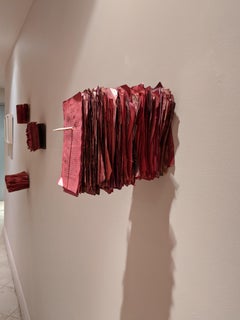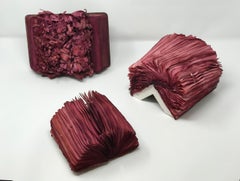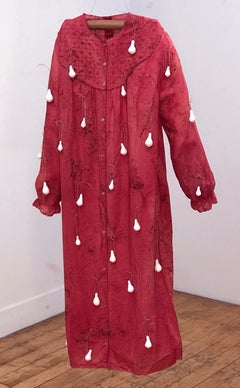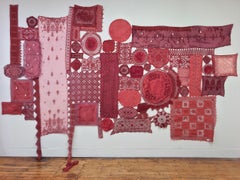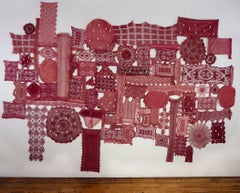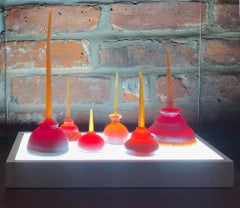ODETTA Sculptures
2010s Feminist Abstract Sculptures
Fabric, Thread, Plaster, Dye, Found Objects
2010s Feminist Abstract Sculptures
Fabric, Thread, Plaster, Dye, Found Objects
2010s Feminist Abstract Sculptures
Fabric, Thread, Dye, Found Objects, Plaster
2010s Feminist Abstract Sculptures
Ceramic, Fabric, Thread, Dye, Found Objects
2010s Feminist Abstract Sculptures
Ceramic, Fabric, Thread, Dye, Found Objects
2010s Conceptual Still-life Sculptures
Glass, LED Light, Pigment
2010s Conceptual Still-life Sculptures
Glass, LED Light, Pigment
2010s Abstract Geometric Abstract Sculptures
Canvas, Found Objects, Acrylic
2010s Minimalist Abstract Sculptures
Stainless Steel
2010s Minimalist Abstract Sculptures
Stainless Steel
2010s Minimalist Abstract Sculptures
Stainless Steel, Wire
2010s Rococo Abstract Sculptures
Acrylic, Wood Panel, Board, Archival Pigment
2010s Rococo Abstract Sculptures
Acrylic, Board, Archival Pigment, Wood Panel
2010s Abstract Abstract Sculptures
Wood, Paint, Found Objects
2010s Conceptual Still-life Sculptures
Glass, Graphite
2010s Conceptual Still-life Sculptures
Glass, Graphite
2010s Conceptual Still-life Sculptures
Steel
2010s Conceptual Abstract Sculptures
Plexiglass
2010s Conceptual Abstract Sculptures
Plexiglass
2010s Conceptual Abstract Sculptures
Plexiglass
2010s Conceptual Abstract Sculptures
Steel
2010s Conceptual Abstract Sculptures
Steel
2010s Conceptual Abstract Sculptures
Steel
2010s Conceptual Abstract Sculptures
Steel
2010s Conceptual Abstract Sculptures
Steel
2010s Conceptual Abstract Sculptures
Steel
21st Century and Contemporary Abstract Geometric Abstract Sculptures
Enamel
21st Century and Contemporary Abstract Abstract Sculptures
Enamel
2010s Abstract Abstract Sculptures
Clay, Wood, Polymer
2010s Abstract Abstract Sculptures
Wood, Putty
2010s Abstract Abstract Sculptures
Copper
2010s Abstract Still-life Sculptures
Wood, Putty
2010s Abstract Abstract Sculptures
Wood, Putty
2010s Abstract Abstract Sculptures
Wood
2010s Mixed Media
Wood, Mixed Media, Acrylic
2010s Arte Povera Mixed Media
Wood, Mixed Media, Acrylic
2010s Abstract Expressionist Abstract Sculptures
Wood, Paint, Found Objects
2010s Abstract Geometric Abstract Sculptures
Canvas, Wood, Found Objects, Acrylic
2010s Conceptual More Art
Tape
2010s Abstract Geometric Abstract Sculptures
Wood, Acrylic
2010s Abstract Geometric Abstract Sculptures
Poplar, Plywood, Acrylic
2010s Abstract Expressionist Abstract Sculptures
Wood, Paint, Found Objects
2010s Abstract Geometric Abstract Sculptures
Paper, Acrylic, Digital Pigment
2010s Abstract Geometric Abstract Sculptures
Paper, Acrylic, Digital Pigment
2010s Minimalist Abstract Sculptures
Archival Paper
2010s Minimalist Abstract Sculptures
Archival Paper
2010s Minimalist Abstract Sculptures
Acrylic, Canvas, Wood
2010s Abstract Geometric Abstract Sculptures
Wood, Acrylic
2010s Abstract Geometric Abstract Sculptures
Acrylic, Wood
2010s Abstract Geometric Abstract Sculptures
Acrylic, Wood
2010s Minimalist Abstract Paintings
Canvas, Wood, Oil
2010s Minimalist Abstract Paintings
Canvas, Wood, Oil
2010s Minimalist Abstract Sculptures
Plaster
2010s Minimalist Abstract Paintings
Canvas, Wood, Oil
2010s Color-Field Abstract Sculptures
Plexiglass, Polyester, LED Light, Acrylic
1990s Abstract Geometric Abstract Sculptures
Terracotta, Acrylic
21st Century and Contemporary Abstract Expressionist Abstract Sculptures
Bronze, Steel
2010s Abstract Geometric Abstract Sculptures
Steel
1970s Feminist Abstract Sculptures
Copper, Steel
1970s Feminist Abstract Sculptures
Copper, Steel
